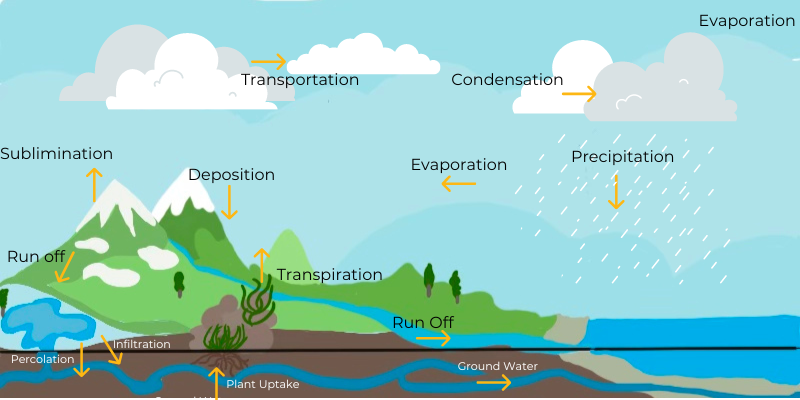The Canopy Project
How Deforestation Affects The Water Cycle
February 8, 2023
The Amazon is a luscious and tropical rainforest filled with trees larger than life, and abundant with beautiful wildlife you won’t find anywhere else in the world. If deforestation levels continue to rise, the Amazon will dry up, turning into a lifeless, flat, and barren wasteland with no memory of the once thriving rainforest. Cutting down trees decreases our source of oxygen, increases atmospheric carbon dioxide concentrations, and directly impacts the water cycle.
The water cycle, also known as the hydrological cycle, is the continuous circulation or movement of water between Earth and the atmosphere. Water evaporates into water vapor, condensing to form clouds, and then precipitating back to land in the form of rain and snow. Other main processes within the cycle include infiltration, runoff, groundwater, and transpiration: all different ways in which water moves across and through the ground. This cycle is important because it supplies water to all living organisms and regulates the planet’s weather patterns. Only 3% of all water in the world is freshwater, meaning 97% is unusable. The water cycle circulates and transports freshwater, allowing for drinking water, water for agriculture, rain, snow, etc.

In connection to deforestation, the hydrological cycle heavily relies on trees to absorb the water in the atmosphere. Trees act as water reservoirs, taking in water from the soil and releasing it through its leaves, also known as transpiration. The added moisture in the air results in cloud formation, leading to rainfall and the continuation of the water cycle. As more and more trees get cut down, evaporation levels are disrupted, drying up the moisture in the air and throwing off the balance of the water cycle. A continual cycle of dry air, low humidity, and decreased precipitation will inevitably lead to a drought-prone, desert-like climate.
Infiltration and runoff are more components of the water cycle impacted by deforestation. Normally, tree roots soak up rainwater, ensuring an adequate amount of infiltration and reduced levels of runoff. However, deforestation promotes the opposite course of action: decreased infiltration and higher amounts of runoff. Without trees, there is nothing to hold the soil cover. Soil erosion rates are increased, causing concerns of flooding and higher likelihoods of pollutants sweeping into nearby water reservoirs.
An example of how deforestation is altering the water cycle in real time can be seen in the Amazon Rainforest. The Amazon’s climate is heavily influenced by the considerable levels of moisture and humidity in the atmosphere which provides high amounts of rain, hence the term “rainforest.” Unfortunately, in the last 50 years, around 17% of the forests have been lost due to deforestation. If deforestation continues, the Amazon is predicted to reach an irreversible tipping point and these man made changes to the hydrological cycle will result in an unsustainable, uninhabitable ecosystem.
Trees are the backbone of life. EARTHDAY.ORG’s campaign, The Canopy Project, plants trees for the purpose of managing biodiversity, decreasing carbon levels in the atmosphere, and fixing the balance of the world’s essential hydrological cycle. Through The Canopy Project, we have rehabilitated heavily deforested areas, such as Cape Town, South Africa, by planting trees to restore the climate, increase rainfall, and preserve water in local aquifers.
Your donations to The Canopy Project help safeguard critical environments struggling under the weight of deforestation by growing trees and protecting the balance of the water cycle.
